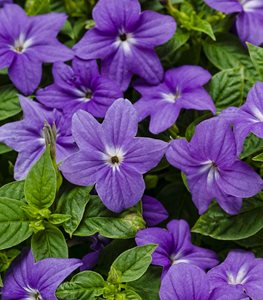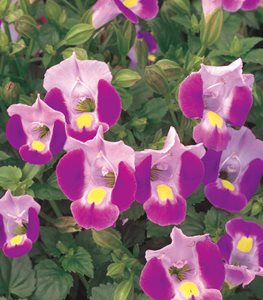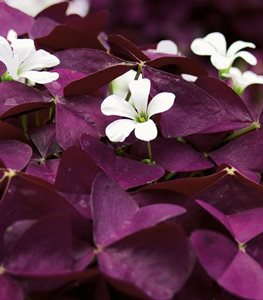19 Amazing Annual Shade Plants
Choose the best shade annuals for your gardenWhen spring finally arrives, who can resist the enticing displays of colorful annuals? For a keen gardener, walking into our favorite garden center is like being a kid let loose in a candy store! The sheer selection can sometimes be overwhelming, and it’s not always easy to know which of those tempting treats is best for shade rather than sun.
We’re here to help and have selected our favorite, top-performing annuals based on years of experience. Understanding that the best designs contain exciting, colorful leaves as well as blooms, we have included both foliage and flowers in our list to guide you as you create your best shade containers yet.
On this page: Fabulous Flowers for Shade | Fantastic Foliage for Shade
FABULOUS FLOWERS FOR SHADE
IMPATIENS
Everyone’s favorite bedding plant, impatiens (Impatiens walleriana) can be used for mass planting in the landscape, or quick color spots for your planters and window boxes, and you can be assured of plenty of compliments—and blooms. Double-flowered varieties such as Rockapulco® Appleblossom (pictured) have the appearance of exquisite miniature roses.
For brighter areas, consider the New Guinea impatiens (Impatiens hawkeri) such as Infinity® Salmon. These have larger flowers and bolder leaves. New Guinea impatiens generally do best with afternoon shade in hotter climates but can tolerate full sun where temperatures are more moderate. Seek advice from your local nursery to make the best selection for your area.
Height/Spread: 10 to 20 inches tall and 1 to 2 feet wide
Try these: Rockapulco® series, Infinity® series.
Read more about how to grow impatiens.
BEGONIA
Think of shade-loving flowers, and begonias are likely to be high on your list. There are so many different types to choose from: the frilly, double blooms of Nonstop® begonias, the compact Rieger begonias, the more tubular flower forms and elongated foliage of Begonia bolivienisis and its hybrids, and more. All begonias combine well with other shade-loving plants or can look spectacular as a solo planting.
Compact wax leaf begonias have been popular for decades as bedding annuals, while newer varieties have improved form and sun tolerance. Also with a waxy leaf, Dragon wing begonias are superb short trailers or mounders, useful both for the landscape or in baskets and planters.
Be careful not to overwater as begonias can be susceptible to mildew.
Height/Spread: Varies considerably with species.
Nonstop® begonias to try: Nonstop series
Rieger begonias to try: Glory Lemon, Solenia Apricot
Boliviensis begonias and hybrids to try: Summerwings Vanilla, Bossa Nova Pure White
Dragon wing begonias to try: Dragon Wing series
Wax leaf begonias to try: Surefire® series
Learn more about growing beautiful begonias.
BROWALLIA
Gaining recognition at last and offering an alternative to impatiens, browallia has flowers in shades of periwinkle blue, white or violet set on compact, mounding plants. Since this does not need deadheading and blooms throughout the season, it offers the shade gardener another easy-care addition for baskets and planters.
Height/Spread: 12 to 16 inches tall and 10 to 14 inches wide
Browallias to try: Endless™ Flirtation, Endless™ Illumination
LOBELIA
Victorian gardens really put lobelia (Lobelia erinus) on the gardening map with their patriotic displays, combining dark blue lobelia with red geraniums and white alyssum. Today’s varieties withstand the mid-summer heat and sun much better than their older cousins yet still perform well in partial shade.
Varieties are available that remain compact or have a short trailing habit ideal for container edges, and bloom in shades of white, blue or lavender.
Lobelia is deer resistant and does not need deadheading.
Height/Spread: 6 to 12 inches tall and 10 to 24 inches wide depending on variety
Compact lobelias to try: Laguna® Compact Blue with Eye
Trailing lobelias to try: Laguna® Cloud White, Techno® Dark Blue
Learn more about growing lobelia in your garden.
WISHBONE FLOWER
Once you try wishbone flower (Torenia fournieri and hybrids), you will always include them in your shade containers. The multi-colored, snapdragon-type flowers are prolific in partial shade and combine well with other annuals. They are best placed at the edge of a container or basket as these are considered short trailers, making them especially well-suited to containers where long trailing stems are not desirable.
The variety Catalina® Midnight Blue is especially effective in combination with orange Bonfire begonia.
Wishbone flower is deer resistant and heat tolerant. It is also considered low maintenance, so deadheading isn't necessary.
Height/Spread: 8 to 16 inches tall and 8 to 10 inches wide
Wishbone flowers to try: Catalina® series
Learn more about growing wishbone flower in your garden.
WOODLAND TOBACCO
Fragrant, deer-resistant, and surprisingly drought tolerant, woodland tobacco (Nicotiana sylvestris) is a show-stopping annual that often self-sows. Its 4-5’ tall stems support clusters of tubular white flowers that are favored by hummingbirds. While these annuals can be grown in full sun, intense heat can cause the large leaves to wilt. Bright, dappled shade such as under deciduous trees or at least some protection from hot afternoon sun offers the ideal conditions.
In average, moisture-retentive soil these rarely need supplemental water once roots have become well established. Woodland tobacco will often self-sow and the seedlings can be transplanted if desired while still small.
Height/Spread: 4 to 6 feet tall, 2 to 3 feet wide
Try: Only the Lonely
FUCHSIA
Whether you prefer single or double blooms, a trailing, upright, or compact habit, pastel shades or rich jewel tones, there is sure to be a fuchsia that is perfect for your design. There are even a few with attractive variegated foliage, such as Firecracker.
Be careful not to allow the plants to dry out and remove the seed pod that resembles a glossy purple cherry after the petals fall to encourage more flowers. Otherwise these are easy care annuals that will reward you with bountiful blooms in the shade while hummingbirds will enjoy the tubular bells of any color.
Fuchsias are frost-tender perennials, but are most often grown as annuals.
Height/Spread: 4 to 30 inches tall and 10 to 30 inches wide depending upon variety
Trailing fuchsias to try: 'Swingtime', 'Lena', Autumnale
Upright fuchsias to try: Firecracker, 'Dollar Princess', Windchimes®, Shadow Dancers® Betty
Learn more about growing fuchsia plants in your garden.
FANTASTIC FOLIAGE FOR SHADE
REX BEGONIAS
Many of us grew Rex begonias (Begonia rex and hybrids) as houseplants in years gone by. Today, like the coleus, these have gained renewed interest as trendsetting foliage plants for summer shade containers.
Large leaves marked with swirls, spots, stripes or splashes in shades of silver, burgundy, pink or green enable you to select the ideal specimen for your color scheme.
For container success, do not overcrowd, as poor air circulation can result in fungal disease. Also avoid overwatering, keeping the soil barely moist but not waterlogged.
Height/Spread: 1 to 3 feet tall and wide
Rex begonias to try: Proven Accents Pegasus, Escargot, Paso Doble
Learn more about how to grow begonias.
COLEUS
Once the staples of our grandparents' living room, coleus (Plectranthus scutellarioides) are fashion-forward foliage plants that are now a staple of designers and keen gardeners alike.
With hundreds of varieties to choose from, be sure to read the tags to determine the ultimate size and preferred lighting conditions. Colors run the gamut, with variegation and multi-hued being standard. Most have an upright habit, but there are also some outstanding trailing varieties.
If your designs have been looking rather dull, a coleus is an easy quick fix.
Height/Spread: 14 to 40 inches high and 12 to 36 inches wide, depending upon habit and variety
Shade-loving coleus to try: ColorBlaze® Sedona Sunset™, ColorBlaze® Strawberry Drop
Read more about growing coleus.
POLKA DOT PLANT
A groundcover in tropical climates and a houseplant beloved by our grandparents—but have you tried these colorful beauties in your container designs yet?
Pink, red, or white leaves are speckled with dark green for a colorful yet elegant look on a plant which is surprisingly easy to care for. Professional designers love the way polka dot plants (Hypoestes phyllostachya) tolerate a variety of shade conditions and evolve beautifully over the season.
Height/Spread: 16 to 22 inches tall and 8 to 14 inches wide
Polka dot plants to try: Hippo® series
Learn more about how to grow and care for polka dot plants.
CALADIUM
Large, heart-shaped, papery leaves add romance and drama to any shade garden, whether in the landscape or a container. While gardeners in warmer climates will be able to grow these from bulbs, everyone can enjoy them by treating them as a tropical houseplant that gets moved outside when night temperatures remain reliably above 55’.
The trick to growing these successfully, especially in containers, is to not overwater them. If you use a drip irrigation system, simply keep the lines away from the crown of the plant.
Remove older leaves as they fade.
Height/Spread: 15 to 20 inches tall and 8 to 14 inches wide
Caladiums to try: Heart to Heart™ series
Read more about how to grow and care for caladiums.
SWEET POTATO VINE
One of the best shade-loving trailing annuals, sweet potato vine (Ipomoea batatas) can be relied upon for adding a bold punch of color to baskets and containers.
While chartreuse varieties may be the most well-known, there are also beautiful bronze and black options to choose from, with habits that vary from modest to extra-long trailers and leaf shapes from heart shaped to finely dissected.
Height/Spread: 4 to 10 inches tall, 2-5 feet wide
Try these: Proven Accents® 'Sweet Caroline Sweetheart Red', Proven Accents® Margarita, Proven Accents® Illusion® Midnight Lace
Learn how to grow sweet potato vine in your garden.
PURPLE HEART
If you need to add some rich purple foliage to your summer designs, purple heart (Setcreasea pallida ‘Purple Heart’) may be the answer. Popular as a groundcover in warmer climates, this tender plant looks stunning weaving and trailing through seasonal baskets and containers, combining equally well with succulents and cottage garden favorites.
The foliage color is richest when grown in bright sunlight and moderately dry soil, yet the plant still performs well in partial shade and typical container conditions. Small pink flowers often stud the segmented branches.
Height/Spread: 12 to 24 inches tall and up to 4 feet wide
MONEYWORT
If you enjoy using the perennial creeping jenny (Lysimachia nummularia) to trail from your shade containers, be sure to experiment with their cousins, moneywort (Lysimachia congestiflora).
Waikiki Sunset (pictured) has bold yellow and green variegated leaves studded with the familiar yellow blooms. This variety is more of a short tumbler than a long trailer. Its colorful foliage brightens up shade designs instantly.
BROMELIAD
Another popular houseplant, Guzmania bromeliads love spending summer in a shady spot outdoors. Sometimes called the scarlet star, they are an exciting way to pierce more traditional plantings with an unexpected form and punch of color.
The colorful bracts range from deepest purple to fiery shades of red, yellow, and orange and last for several months.
These plants do surprisingly well in good quality, well drained potting soil that is allowed to dry out slightly between watering. While it is often recommended to water bromeliads directly into the "cup", the space where the leaves meet and form a cup towards the base of the plant, our experience has been that they thrive with regular drip irrigation or hand watering in containers.
Height/Spread: 1 to 2 feet tall and wide
Bromeliads to try: Classic, Diane
ANTHURIUM
Take your houseplants on a summer vacation! Once night temperatures are sustained above 55 F, it is safe to move the anthuriums and other tropical foliage plants to the patio. Bonus; these are both rabbit and deer resistant.
The glossy heart-shaped “flowers” in shades of red, pink or purple stand high above the green leaves, the central spike, which is often yellow adding contrast, providing many months of color.
As temperatures drop in fall, repot and continue to enjoy this easy-care plant indoors, but be aware that these are considered toxic to cats and dogs.
Height/Spread: 1 to 2 feet tall and wide
Anthuriums to try: Flamenco, Dakota
Learn how to grow anthurium plants.
SHAMROCK
Feeling lucky? Try this deep plum shamrock (Oxalis hybrid) in your shade gardens this year. Each foliage cluster is the size of your palm! Used as a groundcover or color punch in your planters, these delightful plants are sure to delight, while the dark foliage is the perfect foil for the delicate blush-pink flowers.
One of the keys to success is careful watering, especially in a container. It prefers consistently moist yet not saturated conditions, so keep the irrigation lines away from the crown to avoid rotting.
In mild winters, this may be perennial or the plant can be saved as a houseplant if you prefer.
Height/Spread: 6 to 16 inches tall and 10 to 12 inches wide
Shamrock to try: Proven Accents® Charmed® Wine
Learn how to grow shamrock plants in your garden.
SPRENGERI ASPARAGUS FERN
Another tender perennial most often grown as an annual or indoor plant, asparagus ferns (Asparagus densiflorus 'Sprengeri') can add a wonderful feathery look to your summer patio shade gardens. The Sprengeri asparagus fern is one we find especially easy to grow.
Keep the soil moist and provide afternoon shade for this to thrive, then just stand back and watch it weave its way through your hanging baskets and planters. The fine needlelike texture is a perfect way to soften bolder foliage of tropical plants or break up the predictability of a flower-focused design.
Height/Spread: 1 to 2 feet tall and 2 to 3 feet wide
CROTON
Often planted en masse in tropical landscapes and enjoyed as a houseplant in colder areas, crotons (Codiaeum variegatum) also offer spectacular summer color for shade containers. While full sun will scorch the rubbery leaves, this tropical perennial (often grown as an annual) thrives in partial sun/shade where its colorful foliage adds an exotic touch.
If you need to wake up your shade designs, croton may be the perfect solution.
Height/Spread: 1 to 2 feet tall and 1 to 2 feet wide
Varieties to try: Zanzibar, Petra, Oakleaf






















